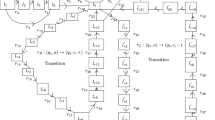Abstract
Motivated by recent techniques developed for observing evolutionary dynamics of a single DNA molecule, we introduce a formal model for accepting an observed behavior of a splicing system. The main idea is to input a marked DNA strand into a test tube together with certain restriction enzymes and, possibly, with other DNA strands. Under the action of the enzymes, the marked DNA strand starts to evolve by splicing with other DNA strands. The evolution of the marked DNA strand is “observed” by an outside observer and the input DNA strand is “accepted” if its (observed) evolution follows a certain expected pattern. We prove that using finite splicing system (finite set of rules and finite set of axioms), universal computation is attainable with simple observing and accepting devices made of finite state automata.
Preview
Unable to display preview. Download preview PDF.
Similar content being viewed by others
References
Adleman, L.M.: Molecular Computation of Solutions to Combinatorial Problems. Science 226, 1021–1024 (1994)
Alhazov, A., Cavaliere, M.: Computing by Observing Bio-Systems: The Case of Sticker Systems. In: Ferretti, C., Mauri, G., Zandron, C. (eds.) DNA 2004. LNCS, vol. 3384, pp. 1–13. Springer, Heidelberg (2005)
Bruchez, M., Moronne, M., Gin, P., Weiss, S., Alavisatos, A.P.: Semiconductor Nanocrystals as Fluorescent Biological Labels. Science 281, 2013–2016 (1998)
Cavaliere, M., Jonoska, N.: (Computing by) Observing Splicing Systems (manuscript, 2004)
Cavaliere, M., Leupold, P.: Evolution and Observation – A New Way to Look at Membrane Systems. In: Martín-Vide, C., Mauri, G., Păun, G., Rozenberg, G., Salomaa, A. (eds.) WMC 2003. LNCS, vol. 2933, pp. 70–87. Springer, Heidelberg (2004)
Cavaliere, M., Leupold, P.: Evolution and Observation — A Non-Standard Way to Generate Formal Languages. Theoretical Computer Science 321, 233–248 (2004)
Cavaliere, M., Leupold, P.: Evolution and Observation — A Non-Standard Way to Accept Formal Languages. In: Margenstern, M. (ed.) MCU 2004. LNCS, vol. 3354, pp. 152–162. Springer, Heidelberg (2005)
Chan, W.C.W., Nie, S.: Quantum Dot Bioconjugates for Ultrasensitive Nonisotopic Detection. Science 281, 2016–2018 (1998)
Goode, E., Pixton, D.: Semi-Simple Splicing Systems. In: Martin-Víde, C., Mitrana, V. (eds.) Where Mathematics, Computer Science, Linguistics and Biology Meet, pp. 343–352. Kluwer Academic Publisher, Dordrecht (2001)
Head, T.: Formal Language Theory and DNA: An Analysis of the Generative Capacity of Specific Recombinant Behaviors. Bulletin of Mathematical Biology 49, 737–759 (1987)
Jovin, T.M., Arndt-Jovin, D.J.: Cell Structure and Function by Microspectrofluorimetry. In: Kohen, E., Ploem, J.S., Hirschberg, J.G. (eds.), pp. 99–117. Academic, Orlando, Florida
Levsky, J.M., Shenoy, S.M., Pezo, R.C., Singer, R.H.: Single-Cell Gene Expression Profiling. Science 297, 836–840 (2002)
Lippincott-Schwartz, J., et al.: Green Fluorescent Proteins. In: Sullivan, K., Kay, S. (eds.), pp. 261–291. Academic, San Diego (1999)
Lippincott-Schwartz, J., Snapp, E., Kenworthy, A.: Studying Protein Dynamics in Living Cells. Nature Rev. Mol. Cell. Biol. 2, 444–456 (2001)
Mateescu, A., Păun, G., Rozenberg, G., Salomaa, A.: Simple Splicing Systems. Discrete Applied Mathematics 84, 145–163 (1998)
Michalet, X., Pinaud, F.F., Bentolila, L.A., Tsay, J.M., Doose, S., Li, J.J., Sundaresan, G., Wu, A.M., Gambhir, S.S., Weiss, S.: Quantum Dots for Live Cells, in Vivo Imaging and Diagnostic. Science 307 (2005), www.sciencemag.org
Păun, G.: Splicing systems with targets are computationally universal. Information Processing Letters 59, 129–133 (1996)
Păun, G., Rozenberg, G., Salomaa, A.: DNA Computing - New Computing Paradigms. Springer, Berlin (1998)
Rigler, R., Elson, E.S.: Fluorescent Correlation Spectroscopy. Springer, New York (2001)
Rozenberg, G., Salomaa, A. (eds.): Handbook of Formal Languages. Springer, Berlin (1997)
Salomaa, A.: Formal Languages. Academic Press, New York (1973)
Author information
Authors and Affiliations
Editor information
Editors and Affiliations
Rights and permissions
Copyright information
© 2006 Springer-Verlag Berlin Heidelberg
About this paper
Cite this paper
Cavaliere, M., Jonoska, N., Leupold, P. (2006). Recognizing DNA Splicing. In: Carbone, A., Pierce, N.A. (eds) DNA Computing. DNA 2005. Lecture Notes in Computer Science, vol 3892. Springer, Berlin, Heidelberg. https://doi.org/10.1007/11753681_2
Download citation
DOI: https://doi.org/10.1007/11753681_2
Publisher Name: Springer, Berlin, Heidelberg
Print ISBN: 978-3-540-34161-1
Online ISBN: 978-3-540-34165-9
eBook Packages: Computer ScienceComputer Science (R0)




